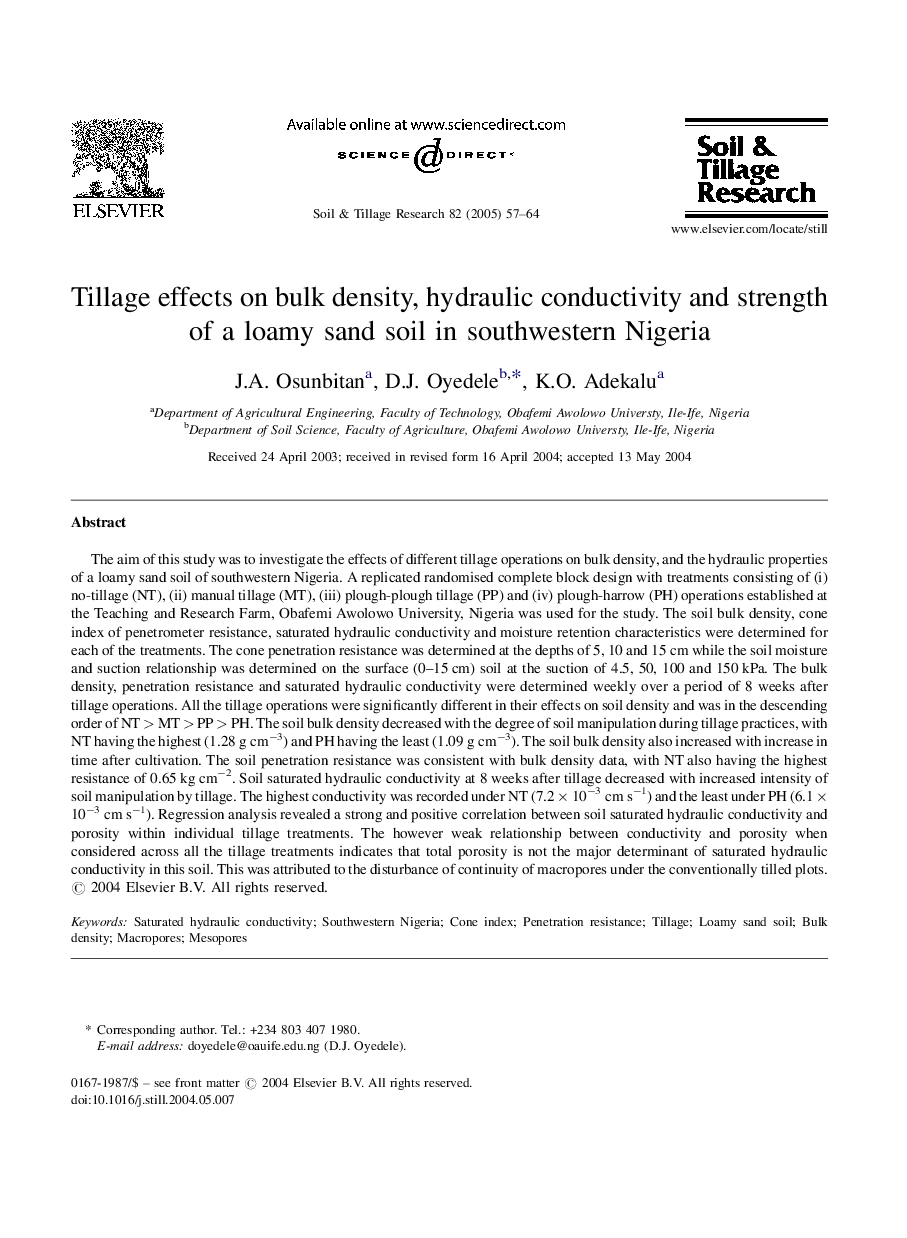| کد مقاله | کد نشریه | سال انتشار | مقاله انگلیسی | نسخه تمام متن |
|---|---|---|---|---|
| 10295398 | 513133 | 2005 | 8 صفحه PDF | دانلود رایگان |
عنوان انگلیسی مقاله ISI
Tillage effects on bulk density, hydraulic conductivity and strength of a loamy sand soil in southwestern Nigeria
دانلود مقاله + سفارش ترجمه
دانلود مقاله ISI انگلیسی
رایگان برای ایرانیان
کلمات کلیدی
موضوعات مرتبط
مهندسی و علوم پایه
مهندسی انرژی
انرژی های تجدید پذیر، توسعه پایدار و محیط زیست
پیش نمایش صفحه اول مقاله

چکیده انگلیسی
The aim of this study was to investigate the effects of different tillage operations on bulk density, and the hydraulic properties of a loamy sand soil of southwestern Nigeria. A replicated randomised complete block design with treatments consisting of (i) no-tillage (NT), (ii) manual tillage (MT), (iii) plough-plough tillage (PP) and (iv) plough-harrow (PH) operations established at the Teaching and Research Farm, Obafemi Awolowo University, Nigeria was used for the study. The soil bulk density, cone index of penetrometer resistance, saturated hydraulic conductivity and moisture retention characteristics were determined for each of the treatments. The cone penetration resistance was determined at the depths of 5, 10 and 15 cm while the soil moisture and suction relationship was determined on the surface (0-15 cm) soil at the suction of 4.5, 50, 100 and 150 kPa. The bulk density, penetration resistance and saturated hydraulic conductivity were determined weekly over a period of 8 weeks after tillage operations. All the tillage operations were significantly different in their effects on soil density and was in the descending order of NT > MT > PP > PH. The soil bulk density decreased with the degree of soil manipulation during tillage practices, with NT having the highest (1.28 g cmâ3) and PH having the least (1.09 g cmâ3). The soil bulk density also increased with increase in time after cultivation. The soil penetration resistance was consistent with bulk density data, with NT also having the highest resistance of 0.65 kg cmâ2. Soil saturated hydraulic conductivity at 8 weeks after tillage decreased with increased intensity of soil manipulation by tillage. The highest conductivity was recorded under NT (7.2 à 10â3 cm sâ1) and the least under PH (6.1 à 10â3 cm sâ1). Regression analysis revealed a strong and positive correlation between soil saturated hydraulic conductivity and porosity within individual tillage treatments. The however weak relationship between conductivity and porosity when considered across all the tillage treatments indicates that total porosity is not the major determinant of saturated hydraulic conductivity in this soil. This was attributed to the disturbance of continuity of macropores under the conventionally tilled plots.
ناشر
Database: Elsevier - ScienceDirect (ساینس دایرکت)
Journal: Soil and Tillage Research - Volume 82, Issue 1, May 2005, Pages 57-64
Journal: Soil and Tillage Research - Volume 82, Issue 1, May 2005, Pages 57-64
نویسندگان
J.A. Osunbitan, D.J. Oyedele, K.O. Adekalu,